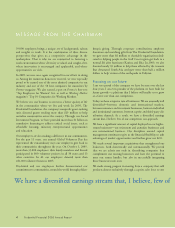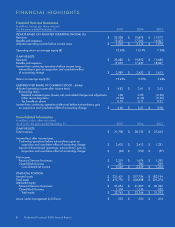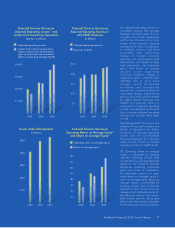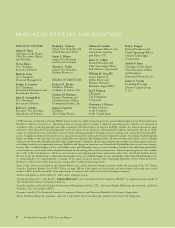Prudential 2005 Annual Report Download - page 16
Download and view the complete annual report
Please find page 16 of the 2005 Prudential annual report below. You can navigate through the pages in the report by either clicking on the pages listed below, or by using the keyword search tool below to find specific information within the annual report.Revenues and Expenses
We earn our revenues principally from insurance premiums; mortality, expense, and asset management fees from insurance and
investment products; and investment of general account and other funds. We earn premiums primarily from the sale of individual life
insurance and group life and disability insurance. We earn mortality, expense, and asset management fees from the sale and servicing of
separate account products including variable life insurance and variable annuities. We also earn asset management and administrative fees
from the distribution, servicing and management of mutual funds, retirement products and other asset management products and services.
Our operating expenses principally consist of insurance benefits provided, general business expenses, dividends to policyholders,
commissions and other costs of selling and servicing the various products we sell and interest credited on general account liabilities.
Profitability
Our profitability depends principally on our ability to price and manage risk on insurance products, our ability to attract and retain
customer assets and our ability to manage expenses. Specific drivers of our profitability include:
• our ability to manufacture and distribute products and services and to introduce new products that gain market acceptance on a
timely basis;
• our ability to price our insurance products at a level that enables us to earn a margin over the cost of providing benefits and the
expense of acquiring customers and administering those products;
• our mortality and morbidity experience on individual and group life insurance, annuity and group disability insurance products;
• our persistency experience, which affects our ability to recover the cost of acquiring new business over the lives of the contracts;
• our cost of administering insurance contracts and providing asset management products and services;
• our returns on invested assets, net of the amounts we credit to policyholders’ accounts;
• the performance of our investment in Wachovia Securities Financial Holdings, LLC, or Wachovia Securities;
• the amount of our assets under management and changes in their fair value, which affect the amount of asset management fees we
receive;
• our ability to generate favorable investment results through asset/liability management and strategic and tactical asset allocation;
and
• our ability to maintain our credit and financial strength ratings.
In addition, factors such as regulation, competition, interest rates, taxes, foreign exchange rates, securities market conditions and
general economic conditions affect our profitability. In some of our product lines, particularly those in the Closed Block Business, we share
experience on mortality, morbidity, persistency and investment results with our customers, which can offset the impact of these factors on
our profitability from those products.
Historically, the participating products included in the Closed Block have yielded lower returns on capital invested than many of our
other businesses. As we have ceased offering domestic participating products, we expect that the proportion of the traditional participating
products in our in force business will gradually diminish as these older policies age, and we grow other businesses. However, the relatively
lower returns to us on this existing block of business will continue to affect our consolidated results of operations for many years. Our
Common Stock reflects the performance of our Financial Services Businesses, but there can be no assurance that the market value of the
Common Stock will reflect solely the performance of these businesses.
See “Risk Factors” included in Prudential Financial’s 2005 Annual Report on Form 10-K for a discussion of risks that could
materially affect our business, results of operations or financial condition, cause the trading price of our Common Stock to decline
materially or cause our actual results to differ materially from those expected or those expressed in any forward looking statements made
by or on behalf of the Company.
Executive Summary
Prudential Financial, one of the largest financial services firms in the U.S., offers clients a wide array of financial products and
services, including life insurance, annuities, pension and retirement-related services and administration, asset management including
mutual funds, banking and trust services, real estate brokerage and relocation services, and, through a joint venture, securities brokerage.
We offer these products and services through one of the largest distribution networks in the financial services industry.
Significant developments and events in 2005 reflect our continued efforts to redeploy capital effectively to seek enhanced returns.
These developments included:
• The continuation of our share repurchase program. In 2005, we repurchased 32.4 million shares of Common Stock at a total cost of
$2.1 billion and are authorized, under a new stock repurchase program authorized by Prudential Financial’s Board of Directors in
November 2005, to repurchase up to an additional $2.5 billion of outstanding Common Stock during 2006.
• A 25% increase in our annual Common Stock dividend, to $0.78 per share.
The income tax provision for 2005 includes a benefit of $720 million from reduction of tax liabilities in connection with the Internal
Revenue Service examination of our tax returns for the years 1997 through 2001.
Prudential Financial 2005 Annual Report14
























